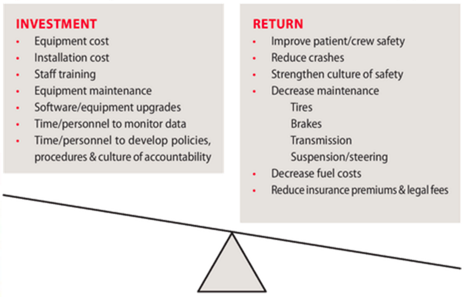4 Must-have Data Points for Dispatch-Billing Alignment and Maximum Reimbursement
The Price of Safety - Evaluating the ROI of Ambulance Safety Technology
Aggressive driving in an industry pressured by response times in competitive markets as well as a mission mentality to save lives is a pervasive problem regardless of agency size, call type or service geography
Was this information valuable?

Aggressive driving in an industry pressured by response times in competitive markets as well as a mission mentality to save lives is a pervasive problem regardless of agency size, call type or service geography. Technologies targeting ways to improve this safety crisis have evolved over the last two decades and three types of safety systems have emerged:
- Surveillance: These systems provide retrospective insight into driving behavior
through data that captures violations of G-forces, speed, turn signals, seat belt utilization
and other factors. Notification of an event can be marked by an audio tone, but
audio, video and/or performance information is retrieved separately at a later time
to review the event. - Coaching: These systems give real-time feedback, through warning lights, audible
tones or even vibrating steering wheel, to inform the driver when driving is becoming
unsafe, such as turning to sharply or lane departures. - Automatic drive controls: These systems interact with the vehicle to limit speed or
even to apply brakes for a full stop in the event of imminent collision. They operate
through GPS-linked information or use radar, cameras or lasers to “read” driving
situations.
Research has provided significant evidence that the use of safety monitoring technology in several EMS fleets across the US made a significant reduction in crash-related injuries and mortality. These published results recommend that the installation of these technologies should become mandatory. They also recognized that the biggest hurdle to overcome would be the cost associated with the technology.
Summary of findings:
- Surveillance: In 2013, Superior elected to begin rollout of a vigorous Safety Management System across the fleet. Their plan was to initially install a surveillance system and to then progress to a driver monitoring/feedback system. The surveillance system consisted of multiple cameras in each truck that were focused on the cab to catch driver and passenger behaviors as well as a camera that recorded activity on the road in front of and behind the vehicle. The surveillance system used was the in-car video system by Digital Ally™. Data for this study was captured from the period immediately after the installation and activation of the Digital Ally™ system.
Vehicle accidents/incidents across several months of accident/incident surveillance showed no significant decrease in the number, type or cost of accidents that occurred. - Coaching: The equipment evaluated in this case study was Road Safety® from Zoll Data Systems. Road Safety captures acceleration, deceleration, and elevated side-to-side g-forces from high-speed turns to grade individual drivers. Other unsafe driving practices such as speeding or not wearing a seat belt would negatively impact the driver grade. Real-time audible warning tones alert the drivers of unsafe actions. As the driver approaches and exceeds preset safety thresholds, the audible tones coach the driver to modify their driving behavior.
Data from Road Safety® devices were extracted from 14 vehicles in 11 ambulance services. The data reflected 6 weeks of performance - three weeks before feedback tones were made audible, and three weeks after. Driver behavior improved significantly as the drivers began to receive real-time feedback about their performance.
The cost of safety in EMS—much like the cost of safety in other areas of public transportation—must be evaluated by the return of employee well-being, extended careers, culture of safety as well as the dollar return on the hard-wired cost of maintenance, fuel and general operations. Culture, policies, procedures and management styles all influence safety performance.

Extending operational safety beyond the black box, the capacity to identify what went wrong after the fact, has a benefit, theoretically, to the operations and culture of any organization. Quantifying that effect is difficult and requires a complex model to measure all the components that matter. Certainly a decision to make the investment requires the chance to evaluate data about the magnitude of the risk in comparison to the cost of mitigation.
Related Posts
How EMS Agencies Can Reframe Need and Refocus Resources With Geospatial Analytics
How To Minimize Radio Chatter and Reduce Guesswork With Smarter Dispatch Resource Management
ZOLL Pulse Blog
Subscribe to our blog and receive quality content that makes your job as an EMS & fire, hospital, or AR professional easier.
ZOLL Pulse Blog
Subscribe to our blog and receive quality content that makes your job as an EMS, fire, hospital, or AR professional easier.




